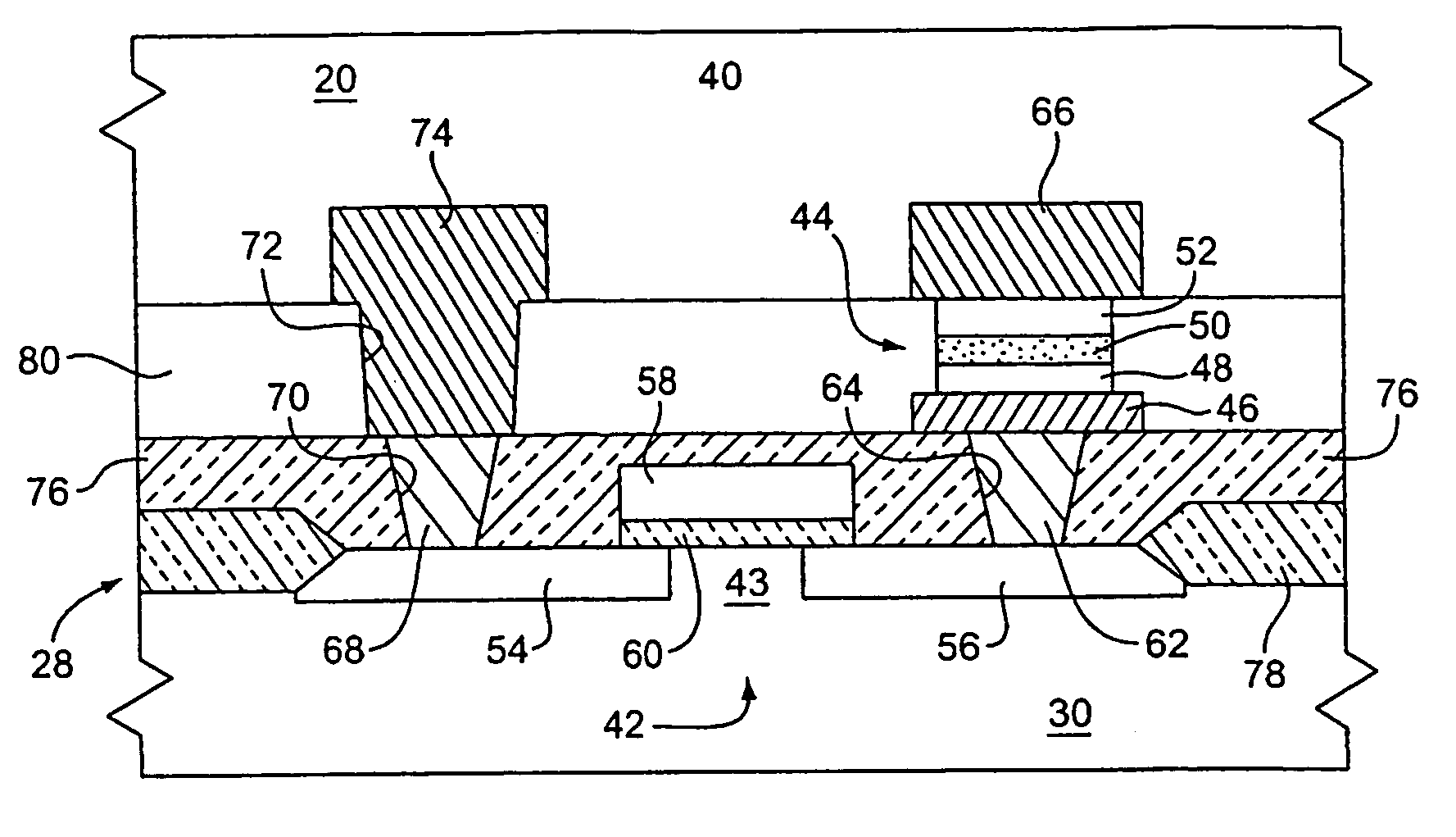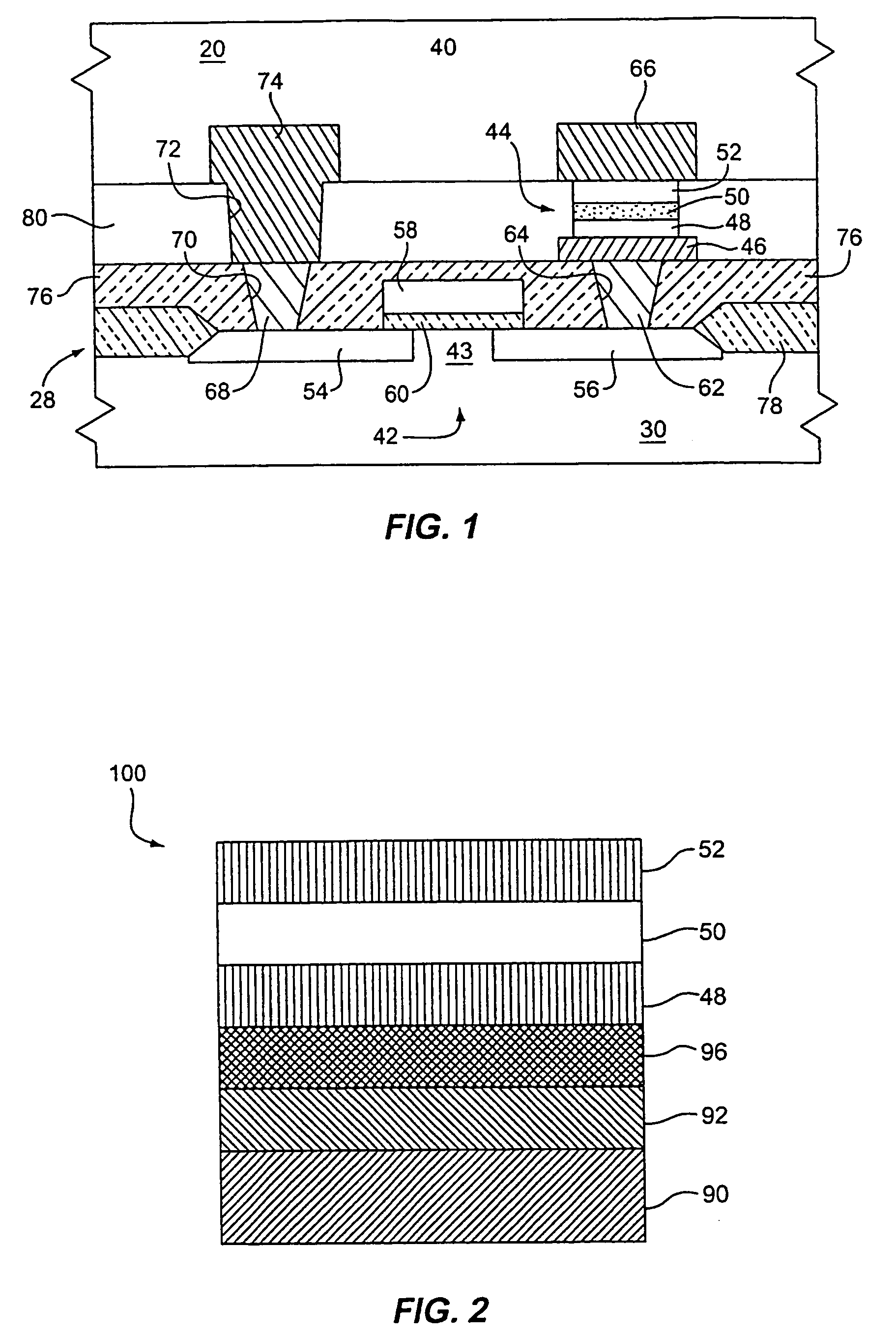Method of making layered superlattice material with improved microstructure
a superlattice material and microstructure technology, applied in the direction of electrical equipment, semiconductor devices, capacitors, etc., can solve the problems of significant decrease in leakage current, increase in remnant polarization, and decrease in shorting problems, so as to improve surface morphology or smoothness, the effect of reducing shorting
- Summary
- Abstract
- Description
- Claims
- Application Information
AI Technical Summary
Benefits of technology
Problems solved by technology
Method used
Image
Examples
example 1
Second Rapid Thermal Anneal After Patterning
[0069]A substrate 28 including capacitor 44 was fabricated in which layered superlattice material layer 50 was layered superlattice material, more specifically, strontium bismuth tantalate (Sr0.9Bi2.2Ta2O9). The precursor solution molarity was approximately 0.10 moles per liter. A substrate 28 comprising a single crystal silicon layer 90, a 5000 Å thick layer 92 of silicon dioxide, a 200 Å thick layer 96 of titanium, and a 2000 Å thick layer 48 of platinum was prebaked at 800° C. in a diffusion furnace for 30 minutes with an oxygen flow of 6 liters / min. The precursor solution was deposited on the substrate 28 by KJC-MOD. Substrate 28 was spun at 2500 RPM for 30 seconds. Substrate 28 was then placed on a hot plate and baked in air at 160° C. for 1 minute. The precursor deposition and baking steps were repeated twice more. Substrate 28 was then placed on a hot plate and baked in air at 260° C. for 4 minutes. Substrate 28 was then transferred...
example 2
Formation of a Strontium Bismuth Tantalate Second Layer
[0072]A substrate 28 including capacitor 44 was fabricated in which layered superlattice material layer 50 was layered superlattice material, more specifically, strontium bismuth tantalate (Sr0.9Bi2.2Ta2O9). The precursor molarity was approximately 0.10 moles per liter. Substrate 28 comprising a single crystal silicon layer 90, a 5000 Å thick layer 92 of silicon dioxide, a 200 Å thick layer 96 of titanium, and a 2000 Å thick layer 48 of platinum was prebaked at 800° C. in a diffusion furnace for 30 minutes with an oxygen flow of 6 liters / min. The precursor solution was deposited on substrate 28 by KJC-MOD. Substrate 28 was spun at 2500 RPM for 30 seconds. Substrate 28 was then placed on a hot plate and baked in air at 160° C. for 1 minute. Substrate 28 was then baked in air at 260° C. for 4 minutes. Substrate 28 was then transferred to a rapid thermal anneal apparatus, then a rapid thermal annealing in oxygen of substrate 28 was...
example 3
Furnace Anneal After the Patterning Process
[0076]Substrate 28, including capacitor 44, was fabricated in which layered superlattice material layer 50 was layered superlattice material, more specifically, strontium bismuth tantalate (Sr0.9Bi2.2Ta2O9). The precursor molarity was approximately 0.10 moles per liter. Substrate 28 comprising a single crystal silicon layer 90, a 5000 Å thick layer 92 of silicon dioxide, a 200 Å thick layer 96 of titanium, and a 2000 Å thick layer 48 of platinum was prebaked at 800° C. in a diffusion furnace for 30 minutes with an oxygen flow of 6 liters / min. The precursor solution was deposited on the substrate by KJC-MOD. Substrate 28 was spun at 2500 RPM for 30 seconds. Substrate 28 was then placed on a hot plate and baked in air at 160° C. for 1 minute. Substrate 28 was then baked in air at 260° C. for 4 minutes, then the steps of applying the precursor through the second baking step were repeated once more. Substrate 28 was then transferred to a rapid ...
PUM
| Property | Measurement | Unit |
|---|---|---|
| temperature | aaaaa | aaaaa |
| temperature | aaaaa | aaaaa |
| temperature | aaaaa | aaaaa |
Abstract
Description
Claims
Application Information
 Login to View More
Login to View More - R&D
- Intellectual Property
- Life Sciences
- Materials
- Tech Scout
- Unparalleled Data Quality
- Higher Quality Content
- 60% Fewer Hallucinations
Browse by: Latest US Patents, China's latest patents, Technical Efficacy Thesaurus, Application Domain, Technology Topic, Popular Technical Reports.
© 2025 PatSnap. All rights reserved.Legal|Privacy policy|Modern Slavery Act Transparency Statement|Sitemap|About US| Contact US: help@patsnap.com



